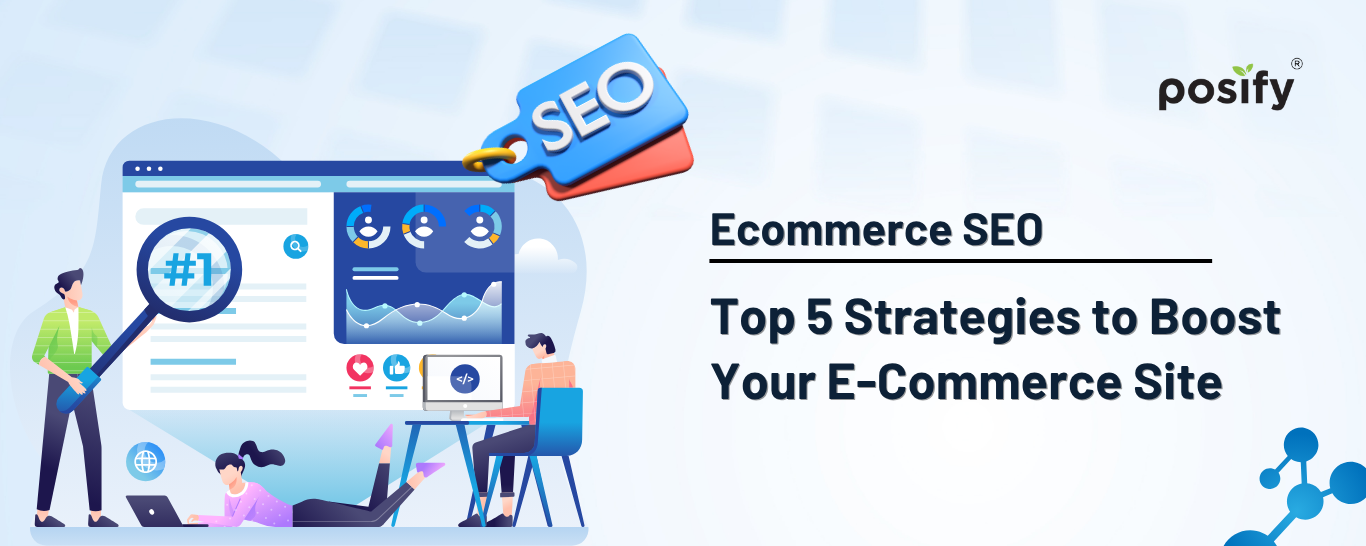Ecommerce SEO Guide: Top 5 Strategies to Boost E-Commerce Site (with Examples)

In today’s competitive ecommerce world, having a sleek online store isn’t enough. If your site doesn’t show up on Google, potential customers won’t find you—and no traffic means no sales. That’s where SEO (Search Engine Optimization) comes in.
A strong SEO strategy gets your products in front of the right people, increases visibility, and drives both clicks and conversions. In this guide, we’ll break down what ecommerce SEO is and share 5 actionable tips to improve your store’s Google rankings.
What Is Ecommerce SEO?
Ecommerce SEO is the process of optimizing your online store so that product, category, and site pages rank higher in organic search results. Unlike traditional SEO, ecommerce SEO focuses heavily on:
- Product page content
- User experience
- Conversion optimization
Optimizing every product page—titles, meta descriptions, keywords, alt text, internal links—can unlock traffic opportunities and attract high-intent buyers.
Ecommerce SEO spans across technical site structure (like speed and mobile-friendliness), content (like product descriptions and reviews), and off-site strategies (like backlinks). It’s a long-term effort, but one that pays off.

Why Ecommerce SEO Matters
Investing in SEO is one of the most cost-effective digital marketing strategies. Here's why it’s crucial for online retailers:
1. Drive Free, Long-Term Traffic
Unlike paid ads, organic traffic doesn’t cost per click. Once you rank, you gain consistent visibility without ongoing ad spend.
2. Capture High-Intent Buyers
Someone searching “best wireless earbuds” is likely ready to purchase. SEO helps your products show up when buyers are actively searching.
3. Build Trust and Authority
Ranking high in search results signals to users that your brand is reputable and trustworthy.
4. Lower Long-Term Marketing Costs
While SEO takes upfront effort, it delivers sustained traffic and better ROI over time compared to PPC ads.
Bottom line: if you're building a long-term ecommerce brand, SEO is a must. The sooner you start, the faster you’ll see results.
.png)
Optimize Product Pages for SEO (With Examples)
Each product page is a potential traffic magnet. Here’s how to optimize them using Posify’s ecommerce platform as an example:
1. Keyword Research
Start by identifying what customers are searching for on Google. Use tools like Google Keyword Planner to find high-intent, long-tail keywords.
To learn more: https://support.google.com/google-ads/answer/7337243?hl=zh-HK)
Tips for choosing keywords:
- Focus on buyer intent keywords like “high-waisted yoga pants” or “men’s waterproof hiking boots”
- Avoid overly broad terms like “pants” or “headphones”
- Target 1–2 main keywords per product page to avoid keyword cannibalization
2. Write SEO-Optimized Titles, Descriptions & URLs
Use customer language and highlight value in your copy.
Below are real examples of weak vs. strong SEO setups
Example: Bluetooth Earbuds
| Weak SEO | Strong SEO | |
| SEO Title | Bluetooth Earbuds | Wireless Noise-Cancelling Earbuds – Long Battery, Fast Pairing |
| SEO Description | High-quality Bluetooth product. | Discover Bluetooth 5.3 earbuds with noise cancellation, long battery life. Free shipping! |
| SEO Keywords | Bluetooth earbuds | wireless earbuds, noise cancelling, Bluetooth headphones |
| SEO URL |
|
www.example.com/bluetooth-earbuds |
Example: Japanese Dress
| Field | Weak SEO | Strong SEO |
|---|---|---|
| SEO Title | Japanese Dress | Must-Have Japanese Summer Dresses – Light, Flowy, Cute Styles |
| SEO Description | Quality Japanese fashion. | 100% cotton V-neck sleeveless dress. Breathable & comfy. Available in black & white. Buy 2, get 1 free! |
| SEO Keywords | Japanese dress | Japanese fashion, summer dresses, kawaii clothing |
| SEO URL | www.example.com/product123 | www.example.com/japanese-summer-dress |
Best Practices:
- Title: Use clear, descriptive titles that match how customers search.
- Description: Focus on product benefits, not just features.
- URL: Keep it short, clean, and keyword-rich.
3. Set Up Product SEO in Posify Platform
On Posify, here’s how to apply your SEO content:
1. Log into your Posify dashboard
2. Go to Products > Retail Products
3. Select a product and click the eye icon to view
.png)
4. Click on SEO Settings
5. Fill in your SEO Title, Keywords, Meta Description, and URL
.png)
Final Thoughts: Let SEO Power Your Online Store
In a crowded ecommerce landscape, SEO is your long-term growth engine. It helps customers find you, without paying for every click.
Remember: SEO isn’t a one-time task—it’s an ongoing strategy. The more consistently you optimize, the more traffic and sales you’ll earn.
Already using Posify? Head to your dashboard and start optimizing your product SEO. Not a user yet? Explore Posify’s all-in-one ecommerce platform with built-in SEO tools to help you launch and grow with ease.
Make SEO your secret weapon—start building your brand’s digital presence today.





